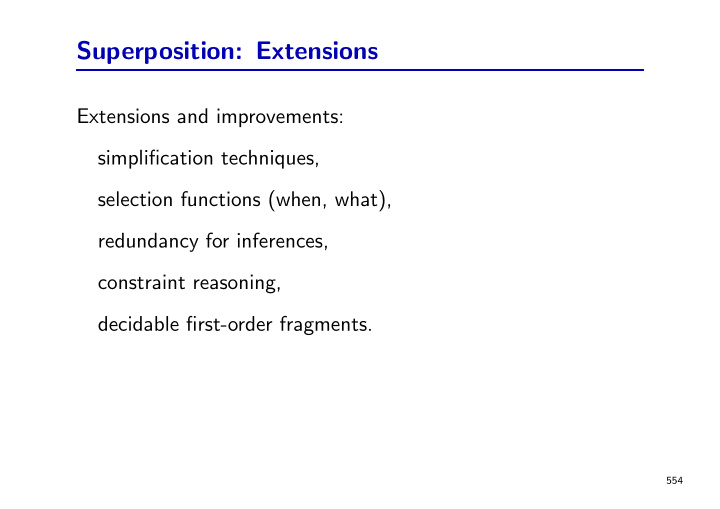



Superposition: Extensions Extensions and improvements: simplification techniques, selection functions (when, what), redundancy for inferences, constraint reasoning, decidable first-order fragments. 554
Theory Reasoning Superposition vs. resolution + equality axioms: specialized inference rules, thus no inferences with theory axioms, computation modulo symmetry, stronger ordering restrictions, no variable overlaps, stronger redundancy criterion. 555
Theory Reasoning Similar techniques can be used for other theories: transitive relations, dense total orderings without endpoints, commutativity, associativity and commutativity, abelian monoids, abelian groups, divisible torsion-free abelian groups. 556
Part 7: Outlook Further topics in automated reasoning. 557
7.1 Satisfiability Modulo Theories (SMT) CDCL checks satisfiability of propositional formulas. CDCL can also be used for ground first-order formulas without equality: Ground first-order atoms are treated like propositional variables. Truth values of P ( a ), Q ( a ), Q ( f ( a )) are independent. 558
Satisfiability Modulo Theories (SMT) For ground formulas with equality, independence is lost: If b ≈ c is true, then f ( b ) ≈ f ( c ) must also be true. Similarly for other theories, e. g. linear arithmetic: b > 5 implies b > 3. We can still use CDCL, but we must combine it with a decision procedure for the theory part T : M | = T C : M and the theory axioms T entail C . 559
Satisfiability Modulo Theories (SMT) New CDCL rules: T -Propagate: M � N ⇒ CDCL(T) M L � N if M | = T L where L is undefined in M and L or L occurs in N . T -Learn: M � N ⇒ CDCL(T) M � N ∪ { C } if N | = T C and each atom of C occurs in N or M . 560
Satisfiability Modulo Theories (SMT) T -Backjump: M L d M ′ � N ∪ { C } ⇒ CDCL(T) M L ′ � N ∪ { C } if M L d M ′ | = ¬ C and there is some “backjump clause” C ′ ∨ L ′ such that = T C ′ ∨ L ′ and M | N ∪ { C } | = ¬ C ′ , L ′ is undefined under M , and L ′ or L ′ occurs in N or in M L d M ′ . 561
7.2 Sorted Logics So far, we have considered only unsorted first-order logic. In practice, one often considers many-sorted logics: read /2 becomes read : array × nat → data . write /3 becomes write : array × nat × data → array . Variables: x : data Only one declaration per function/predicate/variable symbol. All terms, atoms, substitutions must be well-sorted. 562
Sorted Logics Algebras: Instead of universe U A , one set per sort: array A , nat A . Interpretations of function and predicate symbols correspond to their declarations: read A : array A × nat A → data A 563
Sorted Logics Proof theory, calculi, etc.: Essentially as in the unsorted case. More difficult: Subsorts Overloading Better treated via relativization: ∀ x S φ ⇒ ∀ y S ( y ) → φ { x S �→ y } 564
7.3 Splitting Tableau-like rule within resolution to eliminate variable-disjoint (positive) disjunctions: N ∪ { C 1 ∨ C 2 } N ∪ { C 1 } | N ∪ { C 2 } if var ( C 1 ) ∩ var ( C 2 ) = ∅ . Split clauses are smaller and more likely to be usable for simplification. Splitting tree is explored using intelligent backtracking. 565
7.4 Integrating Theories into Superposition Certain kinds of theories/axioms are important in practice, but difficult for theorem provers. So far important case: equality but also: transitivity, arithmetic. . . 566
Integrating Theories into Superposition Idea: Combine Superposition and Constraint Reasoning. Superposition Left Modulo Theories: Λ 1 � C 1 ∨ t ≈ t ′ Λ 2 � C 2 ∨ s [ u ] �≈ s ′ (Λ 1 , Λ 2 � C 1 ∨ C 2 ∨ s [ t ′ ] �≈ s ′ ) σ where σ = mgu( t , u ), . . . 567
Advertisements Interested in Bachelor/Master/PhD Thesis? Automated Reasoning contact Christoph Weidenbach (MPI-INF, MPI-SWS Building, 6th floor) Hybrid System Verification contact Uwe Waldmann Arithmetic Reasoning (Quantifier Elimination) contact Thomas Sturm 568
Advertisements Next semester: Automated Reasoning II Content: Integration of Theories (Arithmetic) Lecture: Block Course Tutorials: TBA 569
570
Recommend
More recommend